冀教版小学英语语法要点
- 格式:ppt
- 大小:691.00 KB
- 文档页数:53
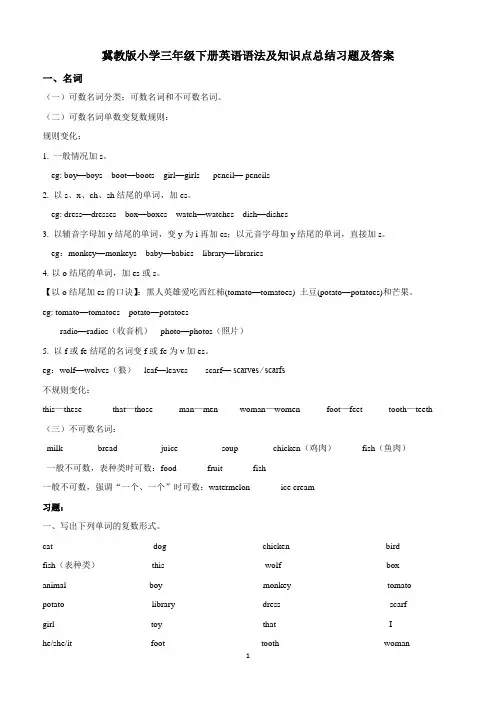
冀教版小学三年级下册英语语法及知识点总结习题及答案一、名词(一)可数名词分类:可数名词和不可数名词。
(二)可数名词单数变复数规则:规则变化:1. 一般情况加s。
eg: boy—boys boot—boots girl—girls pencil— pencils2. 以s、x、ch、sh结尾的单词,加es。
eg: dress—dresses box—boxes watch—watches dish—dishes3. 以辅音字母加y结尾的单词,变y为i再加es;以元音字母加y结尾的单词,直接加s。
eg:monkey—monkeys baby—babies library—libraries4.以o结尾的单词,加es或s。
【以o结尾加es的口诀】:黑人英雄爱吃西红柿(tomato—tomatoes) 土豆(potato—potatoes)和芒果。
eg: tomato—tomatoes potato—potatoesradio—radios(收音机)photo—photos(照片)5. 以f或fe结尾的名词变f或fe为v加es。
eg:wolf—wolves(狼)leaf—leaves scarf—scarves ∕ scarfs不规则变化:this—these that—those man—men woman—women foot—feet tooth—teeth (三)不可数名词:milk bread juice soup chicken(鸡肉)fish(鱼肉)一般不可数,表种类时可数:food fruit fish一般不可数,强调“一个、一个”时可数:watermelon ice cream习题:一、写出下列单词的复数形式。
cat_________ dog_________ chicken_________ bird_________ fish(表种类)_________ this_________ wolf_________ box_________ animal_________ boy________ monkey_________ tomato_________ potato_________ library_________ dress________ scarf_________ girl_________ toy_________ that_________ I_________he/she/it_________ foot_________ tooth_________ woman_________man_________二、单项选择。
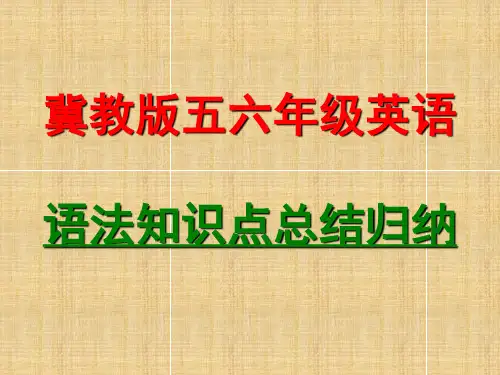
冀教版五六年级英语语法知识点总结归纳一、名词复数规则1.一般情况下,直接加-s,如:book-books,bag-bags,cat-cats,bed-beds2.以s.x.sh.ch结尾,加-es,如:bus-buses,box-boxes,brush-brushes,watch-watches 3.以“辅音字母+y”结尾,变y为i,再加-es,如:family-families,strawberry-strawberries4.以“f或fe”结尾,变f或fe为v,再加-es,如:knife-knives但有些词只加s:roofs,proof s,chiefs.5. 以o结尾的名词,有些加es:Negroes, heroes, tomatoes, potatoes;其它加s: radios, zoos, pianos, photos;zero加s,es均可。
6.不规则名词复数:policeman-policemen, man-men, policewoman-policewomen, foot-feet, mouse-mice woman-women, fish-fish,child-children . tooth-teeth people-people, Chinese-Chinese, Japanese-Japanese写出下列各词的复数I ______ him ______ this ______ her ______watch _______ child _______ photo ________diary ______ day________ foot________ book_______ dress ________ tooth_______ sheep ______ box_______ strawberry ________thief _______ yo-yo ______ peach______sandwich ________ man______ woman_______ paper_______ juice_______ water________milk______ rice______ tea______we them these their watches children photos diaries days feet books dresses teeth sheep boxes strawberries thieves yo-yos peaches sandwichesmen women paper juice water milk rice tea二、一般现在时一般现在时基本用法介绍一般现在时的功能1.表示事物或人物的特征、状态。
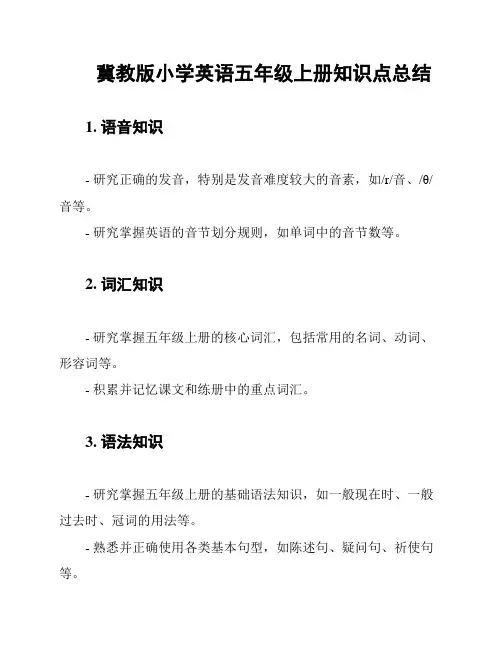
冀教版小学英语五年级上册知识点总结
1. 语音知识
- 研究正确的发音,特别是发音难度较大的音素,如/r/音、/θ/音等。
- 研究掌握英语的音节划分规则,如单词中的音节数等。
2. 词汇知识
- 研究掌握五年级上册的核心词汇,包括常用的名词、动词、形容词等。
- 积累并记忆课文和练册中的重点词汇。
3. 语法知识
- 研究掌握五年级上册的基础语法知识,如一般现在时、一般过去时、冠词的用法等。
- 熟悉并正确使用各类基本句型,如陈述句、疑问句、祈使句等。
4. 阅读理解
- 提高阅读理解能力,通过阅读课文和练册中的短文,并回答相关问题来巩固所学的词汇和语法知识。
5. 口语表达
- 多加练口语,提高语音和语调准确性。
- 学会用简单的语言描述自己和他人的外貌、性格、爱好等。
6. 写作技能
- 研究书写大小写字母的规则,提高字母书写的规范性和美观性。
- 练书写句子和段落,培养书写的逻辑性和连贯性。
以上是冀教版小学英语五年级上册知识点的总结,希望能对你的研究有所帮助。
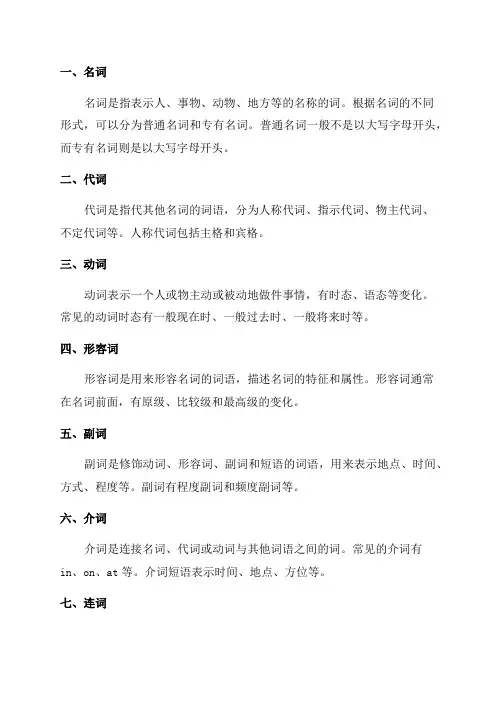
一、名词名词是指表示人、事物、动物、地方等的名称的词。
根据名词的不同形式,可以分为普通名词和专有名词。
普通名词一般不是以大写字母开头,而专有名词则是以大写字母开头。
二、代词代词是指代其他名词的词语,分为人称代词、指示代词、物主代词、不定代词等。
人称代词包括主格和宾格。
三、动词动词表示一个人或物主动或被动地做件事情,有时态、语态等变化。
常见的动词时态有一般现在时、一般过去时、一般将来时等。
四、形容词形容词是用来形容名词的词语,描述名词的特征和属性。
形容词通常在名词前面,有原级、比较级和最高级的变化。
五、副词副词是修饰动词、形容词、副词和短语的词语,用来表示地点、时间、方式、程度等。
副词有程度副词和频度副词等。
六、介词介词是连接名词、代词或动词与其他词语之间的词。
常见的介词有in、on、at等。
介词短语表示时间、地点、方位等。
七、连词连词是连接两个词、短语、句子等的词语,有并列连词、选择连词、从属连词等。
常见的连词有and、but、or等。
八、数词数词是表示数目和顺序的词语,包括基数词、序数词、小数、分数、百分数等。
九、冠词冠词是位于名词前面用来限定名词范围的专用词,有不定冠词和定冠词。
十、谓语动词谓语动词是指一个句子中真正发出动作或表达状态的动词,具有人称、数和时态等变化。
十一、主谓一致主谓一致是指谓语动词和主语在人称和数方面保持一致。
十二、句子的基本结构英语句子的基本结构一般包括主语、谓语、表语、宾语、定语、状语等成分。
十三、简单句和并列句简单句是由一个主谓结构构成的句子,而并列句是由两个或多个简单句通过并列连词连接而成的句子。
十四、疑问句疑问句是用来问问题的句子,根据回答的方式分为一般疑问句和特殊疑问句。
十五、祈使句祈使句是用来表示请求、命令、劝告等的句子,一般省略了主语。
十六、感叹句感叹句是表达强烈的情感、态度的句子,通常以感叹词开头。
十七、间接引语间接引语是通过引述他人的话来间接地表达其中一种含义,常常由连词that引导。
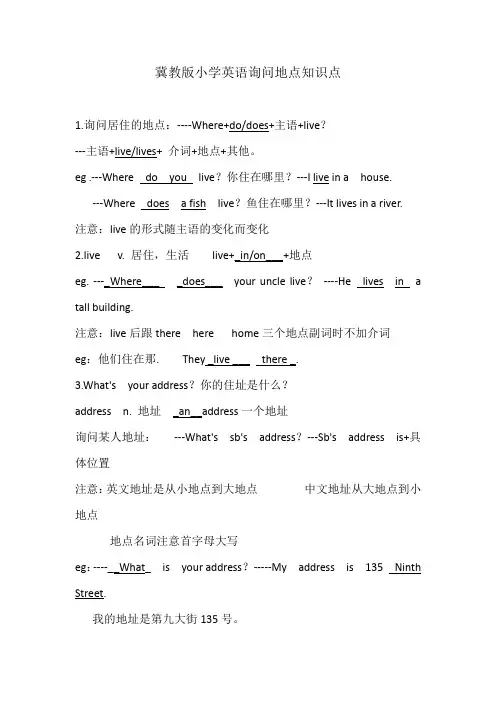
冀教版小学英语询问地点知识点1.询问居住的地点:----Where+do/does+主语+live?---主语+live/lives+ 介词+地点+其他。
eg .---Where do you live?你住在哪里?---I live in a house.---Where does a fish live?鱼住在哪里?---It lives in a river.注意:live的形式随主语的变化而变化2.live v. 居住,生活live+_in/on___+地点eg. ---_Where___ _does___ your uncle live?----He lives in a tall building.注意:live后跟there here home三个地点副词时不加介词eg:他们住在那. They _live ___ there _.3.What's your address?你的住址是什么?address n. 地址_an__address一个地址询问某人地址:---What's sb's address?---Sb's address is+具体位置注意:英文地址是从小地点到大地点中文地址从大地点到小地点地点名词注意首字母大写eg:----__What_ is your address?-----My address is 135 Ninth Street.我的地址是第九大街135号。
I live in Botou, Cangzhou,Hebei province(省),China. 我住在中国,河北省,沧州泊头市。
4.that指示代词(远指)那,那个复数: those 那些对应词:_this_这,这个5. too adv. 副词也,太同音词:two to(1)表示“也”,放于肯定句句末,用逗号于前边的句子隔开。
-I like Miss Huang very much. -__Me___ _too_。
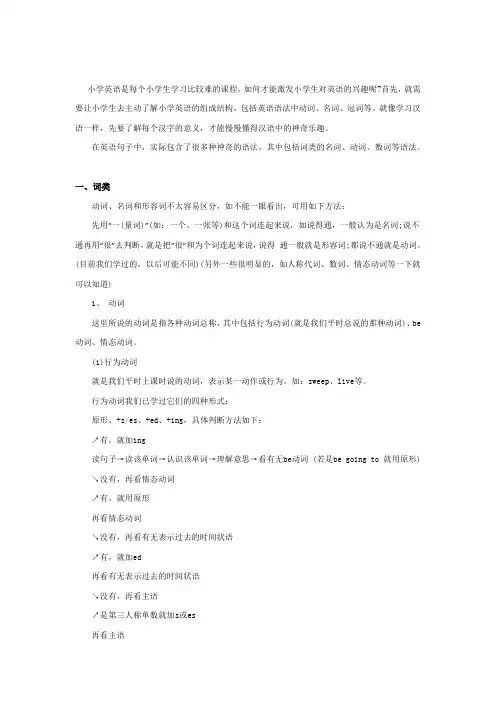
小学英语是每个小学生学习比较难的课程,如何才能激发小学生对英语的兴趣呢?首先,就需要让小学生去主动了解小学英语的组成结构,包括英语语法中动词、名词、冠词等。
就像学习汉语一样,先要了解每个汉字的意义,才能慢慢懂得汉语中的神奇乐趣。
在英语句子中,实际包含了很多种神奇的语法,其中包括词类的名词、动词、数词等语法。
一、词类动词、名词和形容词不太容易区分,如不能一眼看出,可用如下方法:先用“一(量词)”(如:一个、一张等)和这个词连起来说,如说得通,一般认为是名词;说不通再用“很”去判断,就是把“很”和为个词连起来说,说得通一般就是形容词;都说不通就是动词。
(目前我们学过的,以后可能不同)(另外一些很明显的,如人称代词、数词、情态动词等一下就可以知道)1、动词这里所说的动词是指各种动词总称,其中包括行为动词(就是我们平时总说的那种动词)、be 动词、情态动词。
(1)行为动词就是我们平时上课时说的动词,表示某一动作或行为。
如:sweep、live等。
行为动词我们已学过它们的四种形式:原形、+s/es、+ed、+ing,具体判断方法如下:↗有,就加ing读句子→读该单词→认识该单词→理解意思→看有无be动词 (若是be going to 就用原形) ↘没有,再看情态动词↗有,就用原形再看情态动词↘没有,再看有无表示过去的时间状语↗有,就加ed再看有无表示过去的时间状语↘没有,再看主语↗是第三人称单数就加s或es再看主语↘不是第三人称单数就用原形(2)be动词a、Am--was Is --was Are--were 口诀:我用am, 你用are, is用在他她它,所有复数全用are。
b、肯定和否定句 I am (not) from London. He is(not) a teacher. She is(not) in the dining room. My hair is(not) long. Her eyes are(not) small.c、一般疑问句 Am I a Chinese? Yes, you are. No, you aren’t. Are they American? Yes, they are. No, they aren’t. Is the cat fat? Yes, it is. No, it isn’t.我们现在学过的be动词大致分两类:is、am、are为一类,一般用于一般现在时、现在进行时和一般将来时中,was和were为另一类,一般用于一般过去时。

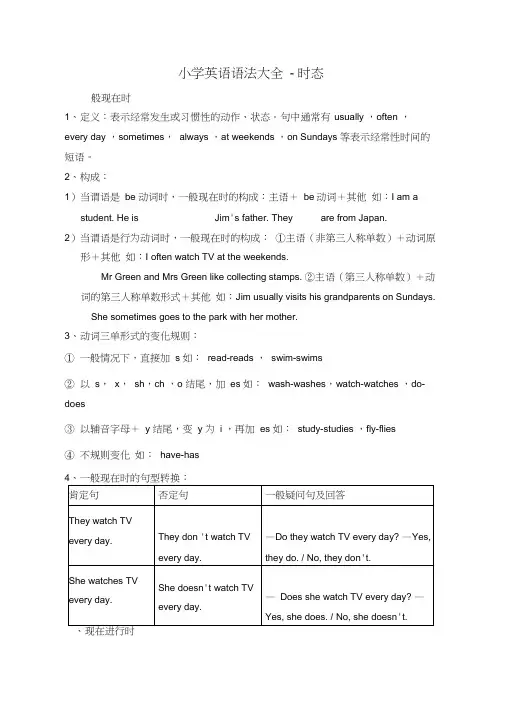
小学英语语法大全- 时态般现在时1、定义:表示经常发生或习惯性的动作、状态。
句中通常有usually ,often ,every day ,sometimes,always ,at weekends ,on Sundays 等表示经常性时间的短语。
2、构成:1)当谓语是be 动词时,一般现在时的构成:主语+be动词+其他如:I am a student. He is Jim's father. They are from Japan.2)当谓语是行为动词时,一般现在时的构成:①主语(非第三人称单数)+动词原形+其他如:I often watch TV at the weekends.Mr Green and Mrs Green like collecting stamps. ②主语(第三人称单数)+动词的第三人称单数形式+其他如:Jim usually visits his grandparents on Sundays.She sometimes goes to the park with her mother.3、动词三单形式的变化规则:①一般情况下,直接加s 如:read-reads ,swim-swims②以s,x,sh,ch ,o 结尾,加es 如:wash-washes,watch-watches ,do-does③以辅音字母+y 结尾,变y 为i ,再加es 如:study-studies ,fly-flies④不规则变化如:have-has4、一般现在时的句型转换:、现在进行时1、定义:表示现在或现阶段正在进行或发生的动作。
句中常有now,look ,listen 等词。
如:I am washing clothes now.Look! Liu Tao is climbing the tree.Listen! Jane is singing in the music room.2、构成:be 动词(am/is/are )+ 动词现在分词(V-ing )3、动词现在分词构成:①一般是在动词原形后加ing如:read-reading ,drink-drinking ,eat-eating ,look-looking②以不发音的 e 结尾的动词,去掉e,再加ing如:write-writing ,make-making,ride-riding ,take-taking③以重读闭音节结尾,如末尾只有一个辅音字母,要双写这个字母,再加ing如:sit-sitting ,swim-swimming,put-putting ,run-running ,stop-stopping ,get-getting ,begin-beginning ,jog-jogging ,forget- forgetting 4、动名词其实就是动词的现在分词,它既有名词性质(可作主语),又有动词性质(可带宾语)。
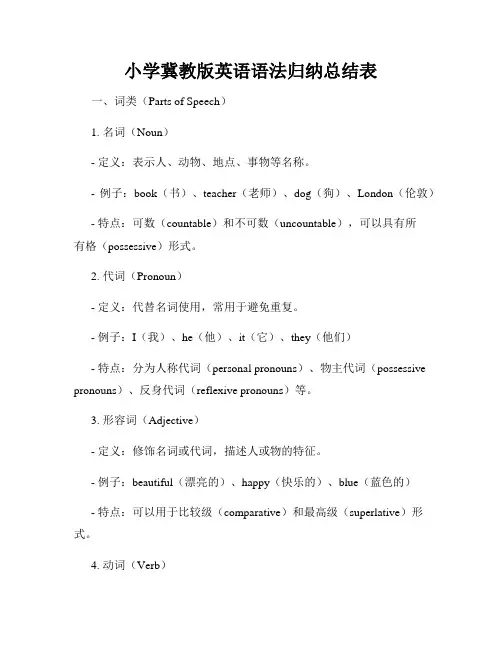
小学冀教版英语语法归纳总结表一、词类(Parts of Speech)1. 名词(Noun)- 定义:表示人、动物、地点、事物等名称。
- 例子:book(书)、teacher(老师)、dog(狗)、London(伦敦)- 特点:可数(countable)和不可数(uncountable),可以具有所有格(possessive)形式。
2. 代词(Pronoun)- 定义:代替名词使用,常用于避免重复。
- 例子:I(我)、he(他)、it(它)、they(他们)- 特点:分为人称代词(personal pronouns)、物主代词(possessive pronouns)、反身代词(reflexive pronouns)等。
3. 形容词(Adjective)- 定义:修饰名词或代词,描述人或物的特征。
- 例子:beautiful(漂亮的)、happy(快乐的)、blue(蓝色的)- 特点:可以用于比较级(comparative)和最高级(superlative)形式。
4. 动词(Verb)- 定义:表示动作、状态或存在。
- 例子:run(跑)、eat(吃)、play(玩)- 特点:根据时态(tense)和语态(voice)的不同形式变化。
5. 副词(Adverb)- 定义:修饰动词、形容词或副词,表示时间、地点、方式等。
- 例子:quickly(快速地)、now(现在)、here(这里)- 特点:可以用于构成比较级和最高级形式。
6. 介词(Preposition)- 定义:连接词与其他词之间的关系。
- 例子:in(在)、on(在……上)、under(在……下)- 特点:常用于表示位置、方向、时间、原因等。
7. 连词(Conjunction)- 定义:连接词组、句子或句子的部分。
- 例子:and(和)、but(但是)、because(因为)- 特点:可以表示并列关系、递进关系、转折关系等。
8. 感叹词(Interjection)- 定义:表示强烈的情感或观点。
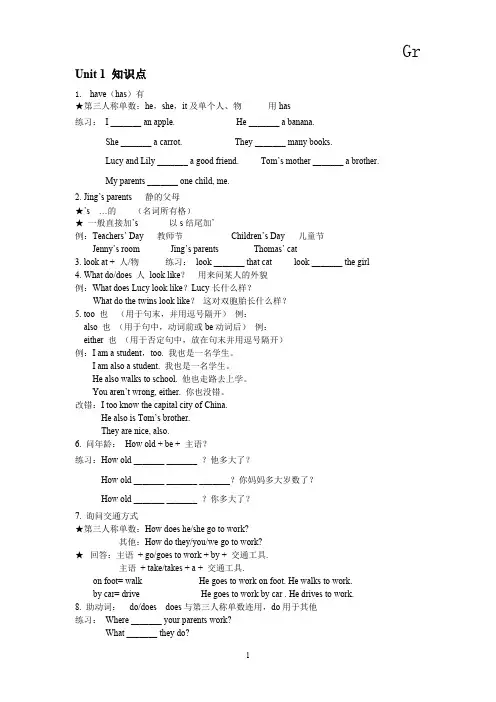
Gr Unit 1 知识点1.have(has)有★第三人称单数:he,she,it及单个人、物用has练习:I _______ an apple. He _______ a banana.She _______ a carrot. They _______ many books.Lucy and Lily _______ a good friend. Tom’s mother _______ a brother.My parents _______ one child, me.2. Jing’s parents 静的父母★’s …的(名词所有格)★一般直接加’s 以s结尾加’例:Teachers’ Day 教师节Children’s Day 儿童节Jenny’s room Jing’s parents Thomas’ cat3. look at + 人/物练习:look _______ that cat look _______ the girl4. What do/does 人look like?用来问某人的外貌例:What does Lucy look like?Lucy长什么样?What do the twins look like?这对双胞胎长什么样?5. too 也(用于句末,并用逗号隔开)例:also 也(用于句中,动词前或be动词后)例:either 也(用于否定句中,放在句末并用逗号隔开)例:I am a student,too. 我也是一名学生。
I am also a student. 我也是一名学生。
He also walks to school. 他也走路去上学。
You aren’t wrong, either. 你也没错。
改错:I too know the capital city of China.He also is Tom’s brother.They are nice, also.6. 问年龄:How old + be + 主语?练习:How old _______ _______ ?他多大了?How old _______ _______ _______?你妈妈多大岁数了?How old _______ _______ ?你多大了?7. 询问交通方式★第三人称单数:How does he/she go to work?其他:How do they/you/we go to work?★回答:主语+ go/goes to work + by + 交通工具.主语+ take/takes + a + 交通工具.on foot= walk He goes to work on foot. He walks to work.by car= drive He goes to work by car . He drives to work.8. 助动词:do/does does与第三人称单数连用,do用于其他练习:Where _______ your parents work?What _______ they do?GrWhere _______ your uncle do? How _______ he go to work?9. 人称代词人称代词人称主格宾格我I me 第一人称我们we us 第二人称你,你们you you 他he him 她she her 它it it 第三人称他们theythem练习:_______ are my little apple. (你) Please come with _______. (我) _______ is a boy.(他) _______ (她)teaches _______ (我们)English. _______ (你)can call _______ (她)Alice. _______(它) is a tiger.10. 询问某人喜欢做什么What do/does + 主语 + like to do ?What do/does + 主语 + like doing ?练习:What _______ you like to do?What _______ your father like to do?What _______ they like to do?What _______ the students like doing?What _______ Bob and Tom like doing?What _______ Tom like to do?Unit 2 知识点1.各国著名景点Tian’anmen Square 天安门广场 the Palace Museum 故宫博物馆the Great Wall 长城 Niagara Falls 尼加拉瓜瀑布CN Tower 加拿大电视塔 White House 白宫the Statue of Liberty 自由女神像 Big Ben 大本钟Buckingham Palace 白金汉宫 (专有名词首字母要大写)2. 复数变化:city – cities 城市leaf – leaves 叶子3. look “看,瞧” 强调看的动作 see “看” 强调看的结果watch “观看,注视” 强调动作(全神贯注的观看、观察或注视某事物的活动)watch TV watch a film/movie 4. 本单元词组a map of … 。
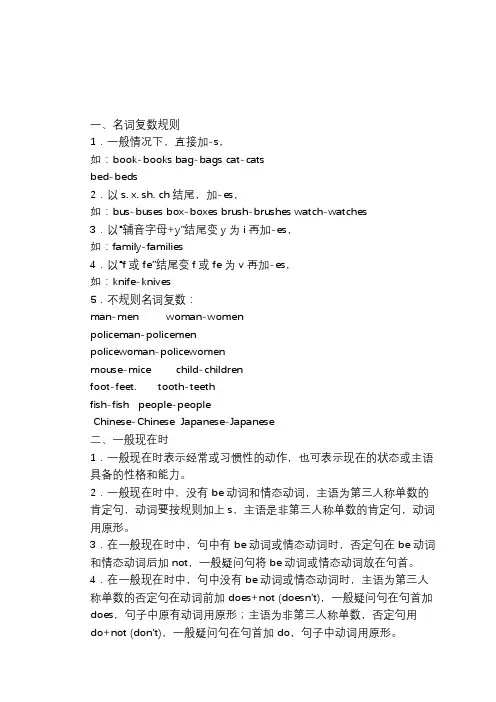
一、名词复数规则1.一般情况下,直接加-s,如:book-books bag-bags cat-catsbed-beds2.以s. x. sh. ch结尾,加-es,如:bus-buses box-boxes brush-brushes watch-watches3.以“辅音字母+y”结尾变y为i再加-es,如:family-families4.以“f或fe”结尾变f或fe为v 再加-es,如:knife-knives5.不规则名词复数:man-men woman-womenpoliceman-policemenpolicewoman-policewomenmouse-mice child-childrenfoot-feet. tooth-teethfish-fish people-peopleChinese-Chinese Japanese-Japanese二、一般现在时1.一般现在时表示经常或习惯性的动作,也可表示现在的状态或主语具备的性格和能力。
2.一般现在时中,没有be动词和情态动词,主语为第三人称单数的肯定句,动词要按规则加上s,主语是非第三人称单数的肯定句,动词用原形。
3.在一般现在时中,句中有be动词或情态动词时,否定句在be动词和情态动词后加not,一般疑问句将be动词或情态动词放在句首。
4.在一般现在时中,句中没有be动词或情态动词时,主语为第三人称单数的否定句在动词前加does+not (doesn’t),一般疑问句在句首加does,句子中原有动词用原形;主语为非第三人称单数,否定句用do+not (don’t),一般疑问句在句首加do,句子中动词用原形。
动词+s的变化规则1.一般情况下,直接加-s,如:cook-cooks milk-milks2 .以s. x. sh. ch. o结尾,加-es,如:guess-guesses wash-washes watch-watches go-goes3.以“辅音字母+y”结尾,变y为i 再加-es,如:study-studies例句示范:(1)I leave home for school at 7:00 every morning.我每天早上7点左右离开家去学校。
冀教版五年级英语上册语法点讲解+练习GrUnit 1 知识点1."Have" or "has" is used for the third person singular pronouns "he"。
"she"。
"it"。
and for singular objects or people。
For example: I have an apple。
He has a banana。
She has a carrot。
They have many books。
Lucy and Lily have a good friend。
Tom'XXX have one child。
me.2.To show n。
add "'s" after a noun。
If the noun ends in "s"。
add only an apostrophe。
For example: Jenny's room。
Jing's parents。
Thomas' cat。
Other examples include Teachers' Day and Children's Day.3."Look at" is used to direct n to a person or object。
For example: Look at that cat。
Look at the girl.4."What do/does + person + look like?" is used to ask about XXX。
For example: What does Lucy look like。
What do the twins look like?5."Too" is used at the end of a XXX"Also" is used in the middle of a sentence。
冀教版中小学英语必会词组句型(一)1. want to do sth 想做某事I want to go to school. 我想去上学。
2. want sb to do sth 想让某人做某事I want my son to go to school.我想让我的儿子去上学。
3. be different from 与......不同The weather in Beijing is different from that of Nanjing.北京的天气和南京的不同。
4. be the same as 与……相同His trousers are the same as mine.他的裤子和我的一样。
5. be friendly to sb 对某人友好Mr. Wang is very friendly to us.王先生对我们非常友好。
6. welcome to +地名欢迎来到某地Welcome to China.欢迎来到中国。
7.What's the matter with sb/sth?某人/某物出什么毛病了?What's the matter with your watch?你的手表怎么了?8. what to do 做什么We don't know what to do next.我们不知道接下来要做什么。
9. let sb do sth 让某人做某事Let him enter the room.让他进入房间。
10. let sb not do sth 让某人不做某事Let him not stand in the rain.让他不要站在雨中。
11.why don't you do sth?你怎么不做某事呢?Why don't you play football with us?你怎么不和我们踢足球呢?12. why not do sth?怎么不做某事呢?Why not play football with us?为什么不和我们踢足球呢?13. make sb sth 为某人制造某物My father made me a kite.我爸爸给我做了一个风筝。
冀教版小学英语语法大全第一章名词一、定义名词是表示人或事物名称的词。
它既可以表示具体的东西,也可以是表示抽象的东西。
二、分类1. 名词可以根据意义分为普通名词和专有名词如:john is a studentstudent是普通名词,john是专有名词普通名词前可以用不定冠词a/an, 定冠词the 或不加冠词,专有名词前一般不加冠词,专有名词的首字母要大写。
2. 普通名词又可以分为个体名词、集体名词、物质名词和抽象名词,其中个体名词与集体名词是可数名词,物质名词和抽象名称是不可数名词。
3. 专有名词专有名词是表示人名、地名、团体、机构、组织等的专有名词,多为独一无二的事物。
三、名词的数1、名词分为可数名词和不可数名词。
可数名词——可以数的名词不可数名词——数不清(没有复数)drink?milk tea water orange juice coke coffee porridgefood?rice bread meat fish fruit cake dumplings2、可数名词与不定冠词a(an)连用有数数形式,不可数名词不能与不定冠词a(an)连用,没有复数形式many+可数名词复数much/a little+不可数名词some, any , a lot of (lots of) 两者都可以修饰。
3、可数名词可以直接用数词来修饰不可数名词数词 +量词 +of + 名词对可数名词的数量提问用how many对不可数名词的数量提问用 how much4、不可数名词的量有以下两种表示方法:1) some, much ,a little ,a lot of ,a bit of , plenty of 用等表示多少。
注意既可以与可数名词复数,又可以与不可数名词连用的有:plenty of ,some ,a lot of ,lots of ,most of 等。
如there is much water in the bottle .瓶中有很多水。
冀教版五年级英语上册语法点讲解+练习GrUnit 1知识点1.have(has)有★第三人称单数:he,she,it及单个人、物用has练习:I _______ an apple.He _______ a banana.She _______ a carrot.They _______ many books.Lucy and Lily _______ a good friend.Tom’s mother _______ a brother.My parents _______ one child, me.2. Jing’s parents静的父母★’s…的(名词所有格)★一般直接加’s以s结尾加’例:Teachers’Day教师节Children’s Day儿童节Jenny’s roomJing’s parentsThomas’cat3. look at +人/物练习:look _______ that catlook _______ the girl4. What do/does人look like?用来问某人的外貌例:What does Lucy look like?Lucy长什么样?What do the twins look like?这对双胞胎长什么样?5. too也(用于句末,并用逗号隔开)例:also也(用于句中,动词前或be动词后)例:either也(用于否定句中,放在句末并用逗号隔开)例:I am a student,too.我也是一位学生。
I am also a student.我也是一名学生。
He also walks to school.他也走路去上学。
You aren’t wrong, either.你也没错。
改错:I too know the capital city of China.He also is Tom’s brother.They are nice, also.6.问年龄:How old + be +主语?练习:How old _______ _______?他多大了?How old _______ _______ _______?你妈妈多大岁数了?How old _______ _______?你多大了?7.询问交通方式★第三人称单数:How does he/she go to work?其他:How do they/you/we go to work?★回答:主语+ go/goes to work + by +交通工具.主语+ take/takes + a +交通工具.on foot= walkHe goes to work on foot. He walks to work.by car= driveHe goes to work by car . He drives to work.8.助动词:do/doesdoes与第三人称单数连用,do用于其他练习:Where _______ your parents work?What _______ they do?1GrWhere _______ your uncle do?How _______ he go to work?9.人称代词人称第一人称第二人称第三人称我我们你,你们他她它他们人称代词主格Iweyouhesheitthey宾格meusyouhimheritthem主格在句中做主语Iwalk to school.IsheBob?宾格放在动词或介词后Letmehelpyou.动动Lookatme.练习:_______ are my little apple.(你)Please come with _______.(我)_______ is a boy.(他)_______(她)teaches _______(我们)English._______(你)can call _______ (她)Alice._______(它)is a tiger.10.讯问或人喜爱做甚么What do/does +主语+ like to do?What do/does +主语+ like doing?练习:What _______ you like to do?What _______ your father like to do?What _______ they like to do?What _______ the students like doing?What _______ Bob and Tom like doing?What _______ Tom like to do?Unit 2常识点1.列国著名景点Tian’anmen Square天安门广场the Palace Museum故宫博物馆the Great Wall长城Niagara Falls尼加拉瓜瀑布CN Tower 加拿大电视塔White House白宫the Statue of Liberty自由女神像Big Ben大本钟Buckingham Palace白金汉宫(专著名词首字母要大写)2.复数变革:city–cities城市leaf–leaves叶子3. look“看,瞧”夸大看的举措see“看”强调看的结果watch“寓目,凝视”夸大举措(全神灌注的寓目、窥察或凝视某事物的举动)watch TVwatch a film/movie4.本单元词组a map of…。
冀教版小学英语语法总结sleep sleeps sleeping slept 冀教版小学英语语法总结(一)read reads reading readjump jumps jumping jumped 动词的变化skip skips skipping skipped 原形单三现在分词过去式run runs running ranshop shops shopping shopped walk walks walking walkedremember -s -ing remembered look looks looking lookedforget forgets forgetting forgot talk talks talking talkedwrite writes writing wrote play plays playing playedwant wants wanting wanted watch watches watching watchedsit sits sitting sat help helps helping helped listen listens listening listened happen happens happening happened take takes taking took go goes going went get gets getting got see sees seeing saw am / / was have has having had is / / wasare / / were eat eats eating ate teach teaches teaching taught do does doing did say says saying said miss misses missing missed want wants / wanted hurt hurts hurting hurtwin wins / won fall falls falling felllose loses / lost lie lies lying laylaugh laughs laughing laughed break breaks breaking brokethink thinks thinking thought buy buys buying boughtput puts putting putlike likes / liked不可数名词: 冀教版小学英语语法总结(二)juicemilk a, an与some 合成词: water a(加在以非元音音素开头的名词前)class+room=classroom pop book bed+room=bedroom tea desktooth+brush=toothbrush soup pen swim+suit=swimsuit glue pencilpolice+man=policeman chalk marker head+ache=headache paper truckbasket+ball=basketballbicycle suit+case=suitcase 可数名词复数形式: girlpencil+case=pencilcase sandwiches bus play+groud=playgroud dumplings glass stomach+ache=stomachanoodles snack che fruit man post+man=postman grapes woman super+man=superman oranges baby bath+room=bathroom scissors child air+plane=airplane people an(加在以元音音素开头的名词前) women apple men orange children eggapartment 冀教版小学英语语法总结(三)形容词与副词 some(用于可数名词复数形式及不可数名词前,表示一形容词副词些) quick quicklyWould you like some ice-cream? slow slowlyquiet quietly名词单数变复数的特例: loud loudlyfoot---feet tooth---teeth brush---brushes toothbrush---toothbrushes sad sadlyman---men woman---women child---children baby---babies happy happily leaf---leaves 注:形容词用于修饰名词。